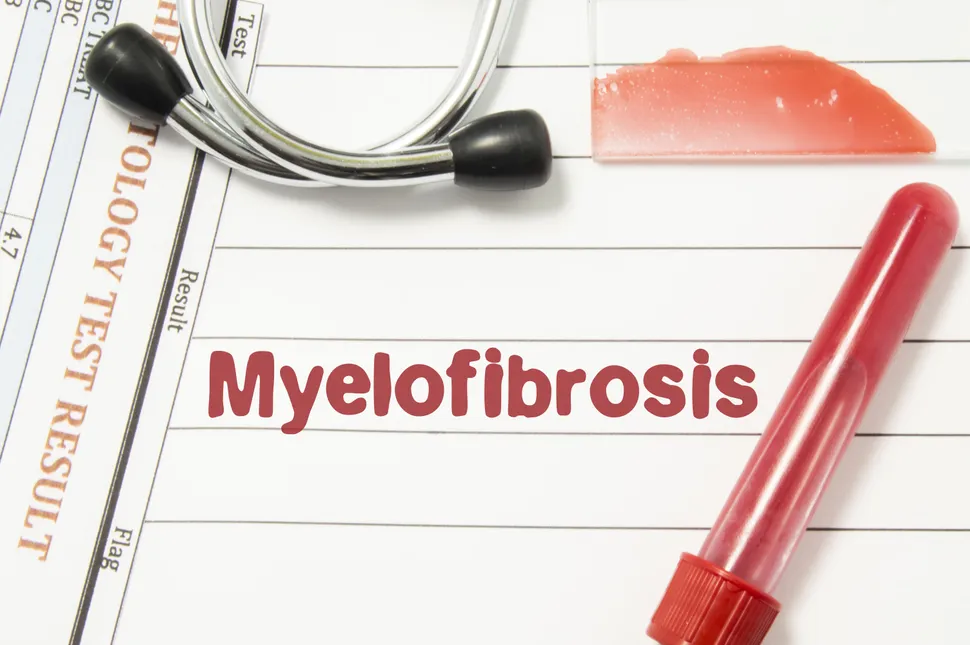What Is The Prognosis Of A Myelofibrosis Patient?

According to the Cleveland Clinic, myelofibrosis is a rare type of blood cancer where the bone marrow is replaced by fibrous scar tissue. The scarring and the excess cancer cells can prevent the bone marrow from making healthy blood cells.
Receiving a cancer diagnosis like myelofibrosis can often bring forward the questions "How long will I live with this disease?" or "What can I expect the quality of life of my loved one to be?"
These are important and valid questions that deserve answers. Unfortunately, with a diagnosis like myelofibrosis, it's not always as simple as it might seem. In solid tumor cancers,(like breast cancer or colon cancer) it's easier to correlate the prognosis of the patient with the stage of cancer they are diagnosed with, but in myelofibrosis, the evaluation is not as obvious.
Myelofibrosis has a median survival rate of six years, which means that about 50% of diagnosed people live less than six years, and about the same number of people live longer than six years.
So, how long should I expect to have myelofibrosis?
According to the Merriam-Webster dictionary, prognosis means "the prospect of recovery as anticipated from the usual course of disease or peculiarities of the case".
In other words, knowing one's myelofibrosis prognosis would give them a glimpse into how well they will live with the disease and how likely they are to make a full recovery.
Now, while there is no current cure for all myelofibrosis patients because even if allogeneic stem cell transplantation is a potential cure, not everyone can receive this treatment; the longevity of patients and their quality of life is the primary goal of all treatment options.
Multiple factors affect prognosis, including:
- Age
- Symptoms
- Number of blood cells reported in the bone marrow biopsy
- Complete blood count
- The severity of the scarring in the bone marrow
- The presence of genetic mutations like JAK, CALR and MPL
What is the Longest-Known Survival with Myelofibrosis?
While this question seems pretty straightforward, it’s challenging to respond to because there are multiple causes that lead to myelofibrosis, and each case is different.
The longest-known survival of myelofibrosis is difficult to pinpoint precisely, as individual cases can vary widely and medical records may not always be available or complete. However, there have been cases reported where individuals with myelofibrosis have survived for decades. As noted above, some patients have lived well beyond 20 years since their initial diagnosis.
It's important to note that these cases of exceptionally long survival are likely to be influenced by a combination of factors, including:
- Early diagnosis: Catching the disease in its early stages before it has progressed significantly can lead to better outcomes and longer survival.
- Effective treatment: Individuals who have responded well to treatments and achieved durable remissions are more likely to experience longer survival.
- Advancements in treatment: The development of new treatment options and therapeutic approaches has significantly improved the outlook for myelofibrosis patients over the years.
- Supportive care: Improved supportive care measures help manage treatment side effects and maintain overall quality of life.
- Genetic and molecular factors: Some individuals may have specific genetic or molecular characteristics of their disease that make it more responsive to treatment, for example, the JAK mutation which responds to Jak2 inhibitors. Those with high-risk genetic translocations, deletions, or additions of their disease often have a harder time achieving and maintaining deep responses.
- Individual variation: Each person's response to treatment and disease progression can vary widely, making long-term survival possible in some cases.
Unlock Personal Insights Into Your Diagnosis for Free with HealthTree Cure Hub
By securely connecting your electronic health records, HealthTree Cure Hub allows you to discover treatment options, find a specialist, keep track of your disease and so much more! Sign up for a free patient account today to get started.
According to the Cleveland Clinic, myelofibrosis is a rare type of blood cancer where the bone marrow is replaced by fibrous scar tissue. The scarring and the excess cancer cells can prevent the bone marrow from making healthy blood cells.
Receiving a cancer diagnosis like myelofibrosis can often bring forward the questions "How long will I live with this disease?" or "What can I expect the quality of life of my loved one to be?"
These are important and valid questions that deserve answers. Unfortunately, with a diagnosis like myelofibrosis, it's not always as simple as it might seem. In solid tumor cancers,(like breast cancer or colon cancer) it's easier to correlate the prognosis of the patient with the stage of cancer they are diagnosed with, but in myelofibrosis, the evaluation is not as obvious.
Myelofibrosis has a median survival rate of six years, which means that about 50% of diagnosed people live less than six years, and about the same number of people live longer than six years.
So, how long should I expect to have myelofibrosis?
According to the Merriam-Webster dictionary, prognosis means "the prospect of recovery as anticipated from the usual course of disease or peculiarities of the case".
In other words, knowing one's myelofibrosis prognosis would give them a glimpse into how well they will live with the disease and how likely they are to make a full recovery.
Now, while there is no current cure for all myelofibrosis patients because even if allogeneic stem cell transplantation is a potential cure, not everyone can receive this treatment; the longevity of patients and their quality of life is the primary goal of all treatment options.
Multiple factors affect prognosis, including:
- Age
- Symptoms
- Number of blood cells reported in the bone marrow biopsy
- Complete blood count
- The severity of the scarring in the bone marrow
- The presence of genetic mutations like JAK, CALR and MPL
What is the Longest-Known Survival with Myelofibrosis?
While this question seems pretty straightforward, it’s challenging to respond to because there are multiple causes that lead to myelofibrosis, and each case is different.
The longest-known survival of myelofibrosis is difficult to pinpoint precisely, as individual cases can vary widely and medical records may not always be available or complete. However, there have been cases reported where individuals with myelofibrosis have survived for decades. As noted above, some patients have lived well beyond 20 years since their initial diagnosis.
It's important to note that these cases of exceptionally long survival are likely to be influenced by a combination of factors, including:
- Early diagnosis: Catching the disease in its early stages before it has progressed significantly can lead to better outcomes and longer survival.
- Effective treatment: Individuals who have responded well to treatments and achieved durable remissions are more likely to experience longer survival.
- Advancements in treatment: The development of new treatment options and therapeutic approaches has significantly improved the outlook for myelofibrosis patients over the years.
- Supportive care: Improved supportive care measures help manage treatment side effects and maintain overall quality of life.
- Genetic and molecular factors: Some individuals may have specific genetic or molecular characteristics of their disease that make it more responsive to treatment, for example, the JAK mutation which responds to Jak2 inhibitors. Those with high-risk genetic translocations, deletions, or additions of their disease often have a harder time achieving and maintaining deep responses.
- Individual variation: Each person's response to treatment and disease progression can vary widely, making long-term survival possible in some cases.
Unlock Personal Insights Into Your Diagnosis for Free with HealthTree Cure Hub
By securely connecting your electronic health records, HealthTree Cure Hub allows you to discover treatment options, find a specialist, keep track of your disease and so much more! Sign up for a free patient account today to get started.

about the author
Audrey Burton-Bethke
Audrey is a content writer and editor for the HealthTree Foundation. She originally joined the HealthTree Foundation in 2020. Audrey loves spending time with her supportive husband, energetic four-year-old, and new baby.
More on Core Education
Trending Articles
Get the Latest Myelofibrosis Updates, Delivered to You.
By subscribing to the HealthTree newsletter, you'll receive the latest research, treatment updates, and expert insights to help you navigate your health.
Together we care.
Together we cure.
3x Faster.









